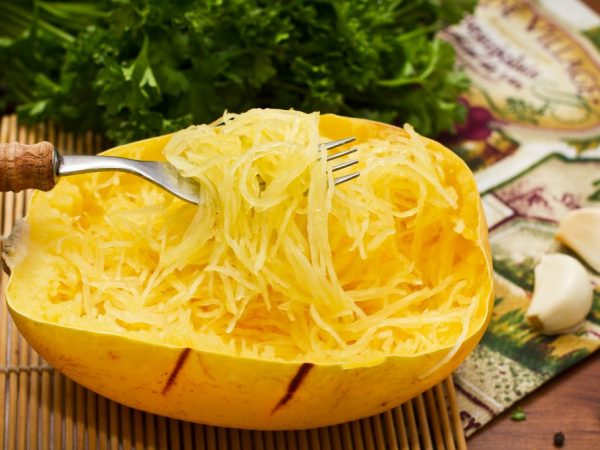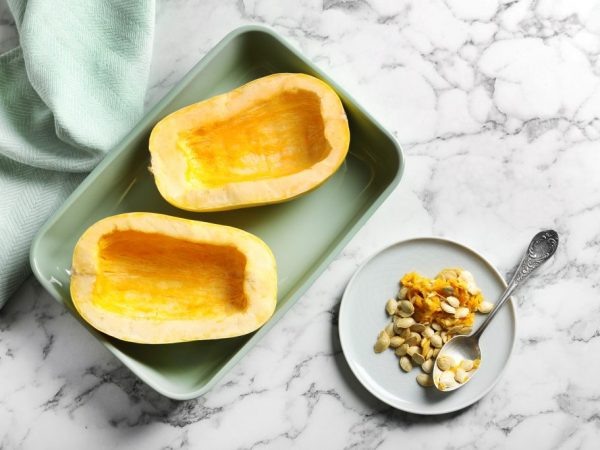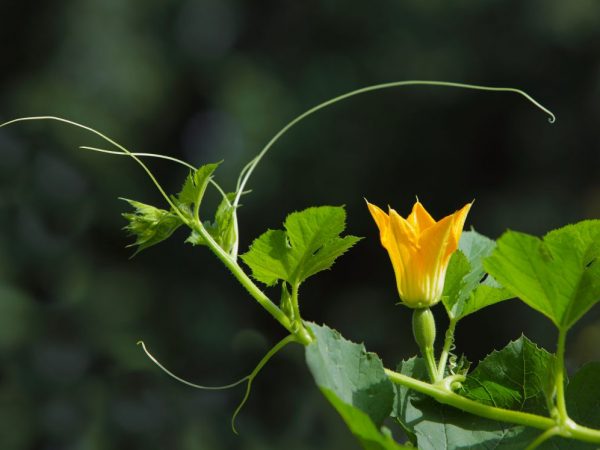Growing Pumpkin Spaghetti
Pumpkin Spaghetti (Squash) is native to North America. It was raised and used in food by the Indians who lived in Massachusetts. Indian squash is translated as "eaten raw, uncooked." This is logical, since these people ate raw pumpkin and constantly consumed the seeds of this vegetable.

Growing Pumpkin Spaghetti
Characteristic
The pumpkin has an oblong shape, divided into segments, and a bright rich color (from yellow to orange-red). The texture of the flesh is very dense, and the peel of the ripe fruit is hard, thanks to which the Spaghetti variety can persist almost until spring. The mass of one vegetable reaches an average of about 1-2 kg.
This vegetable produces a large harvest. Its stems grow rapidly and reach up to 8 m in length. The plant weaves well both on specially set nets, and simply on the ground. Fruits can be harvested from late July until almost frost.
Beneficial features
The main thing that is valuable in this vegetable is its low calorie content and minimal sugar content, which is why squash is considered a dietary product. If you try a fresh vegetable, its flesh will have a slightly sweet taste and a crunchy texture that resembles a young walnut.
Eating pumpkin both raw and cooked has the following positive effects:
- helps to remove excess water from the body;
- eliminates edema;
- tidies up the nervous system;
- normalizes sleep;
- promotes normal digestion;
- favorably affects the condition of the skin.
Growing seedlings
This variety is very easy to grow. The plant does not require a strict regime of heat and moisture; almost any soil is suitable for it. The only thing to keep in mind is organic and potash fertilizers. Such dressings are suitable for squash pumpkin, especially if it is grown in poor and dry soil.
Timing
If the growing conditions are suitable (enough moisture and heat), then the seeds can be sown directly in the open ground, but in certain climates it will be much better to germinate the seedlings at home first. This should be done in late April - early May. This period is the most favorable for sowing seedlings.
Priming
Pumpkin seedlings are very fragile, so it is better to use special peat pots for growing, with which you can then put it directly into the garden. They must be taken at least 6 × 6 cm in size.
Soil for seeds can be of two types:
- purchased from a gardening store (generic or cucumber substrate);
- cooked independently: small sawdust, peat and humus in a ratio of 1: 2: 1 and nitroammophoska (1 tsp per 1 kg of soil).
Seed preparation

Seeds can be prepared by yourself
Before planting, you need to prepare the seeds. You can either buy them in a specialized store, or in the fall you can collect them and prepare them yourself (do not dry them in the oven, only at room temperature). You need to store the planting material in a tight cloth bag in a dark and dry place.
Before sowing seeds, you must:
- go over them, throw out the empty ones and use only large ones ("pot-bellied");
- soak the seeds in warm water overnight;
- then wrap it in a tight damp cloth and keep it for 2-3 days (periodically moisten the cloth with water) - this speeds up the process of seed germination.
Only after the above procedures can the planting material be placed in pots with soil.
Sowing
Gardeners recommend sowing pumpkin seeds in pots 20 days before planting in open ground (this is about the second half of May). The pots must be tightly filled with the substrate and watered abundantly, then make recesses about 5 cm deep and sow the seeds, covering them with the substrate.
If the planting material is sown not in pots one by one, but in boxes or other containers, it is recommended to fill the bottom with sawdust, with a layer thickness of about 4 cm - this allows the soil to retain moisture longer.
Care
Before the seedlings germinate, the pots must be covered with foil or glass on top to create a greenhouse effect. The temperature should be no more than 25 ° C during the day and no less than 15 ° C at night. After the sprouts appear, you need to lower it a little (place the pots in a cooler place).
The lower temperature prevents the plant from growing upward quickly (so that it does not turn out to be tall and thin). Watering should be moderate. After 7-10 days, the seedlings need to be fertilized (2 g of nitrophoska per 1 liter of water, while trying not to get on the plant itself).
Transplanting into open ground
The seedlings should be in pots until they reach 15-20 cm, when at least 2 full-fledged leaves have already been formed. Then it can be planted in open ground.
The description indicates that Spaghetti pumpkin seedlings grow well on land where potatoes or legumes were formerly cultivated. There is no need to transplant it to the place where its “relatives” grew (cucumbers, zucchini, onions). The earth needs to be dug up and fluffed up (it should be fertilized in the fall).
Planted with the calculation of 1 sprout per 1 sq. m., because the pumpkin grows very intensively. If you transplant it from a peat pot, then you do not need to shake off the soil. If the seedlings are grown in boxes, you should take some soil with the plant so as not to damage the root. It is better to plant it in the evening or in the afternoon in cloudy weather.
Care

Taking care of the plant is easy
Outdoor care of this crop has several important aspects:
- watering. It is necessary to irrigate seedlings in the open field if there is dry hot weather outside for several days. You need to water at the root, not the leaves, and preferably in the evening, so that the sun does not form a crust on the ground;
- weeding. If the seedlings are sown correctly, then weeding is not needed. Care must be taken that the stems are not strongly intertwined. To do this, their length can be shortened by cutting off the edges;
- loosening the soil. It is necessary to periodically remove the weed from the garden so that it does not take moisture from the plants. This should be done by loosening the soil. After this procedure, it better absorbs water, heat and feeding;
- it is best to use store-bought, ready-made, mixtures for plant nutrition. They are diluted with water according to the instructions and already contain all the necessary elements. You can add nitroammofosku (15 g per 10 l of water) or make a solution of humus.
Harvesting
The Spaghetti variety is harvested later than all vegetables - starting in mid-October, already before the frost. A sign of a ripe pumpkin is the death of the stalk and its transformation into a hard tail. The peel of a ripe vegetable becomes hard, even difficult to cut.
The vegetable must be removed before frost, otherwise it will start to deteriorate. You need to store the fruits in a cool dark place.
Diseases and pests
Pumpkin Squash, like all crops, is susceptible to diseases and pests. The main ones are:
- bacteriosis - brown and yellow spots on the leaves, which lead to the drying out of the plant, you can fight it with a solution of copper sulfate;
- white rot - covering the fruit with a white bloom, this is due to a fungus that appears due to excessive moisture - you need to treat the fruits with activated carbon powder (treat areas) and copper sulfate;
- powdery mildew - white spots on the leaves and embryos of fruits, which lead to the death of the plant: these are spores of fungi that need to be eliminated by treating the leaves with a 70% colloidal sulfur solution;
- a spider mite infects the leaves from the inside, which leads to their drying out - spraying with tincture of onion and garlic husks several times a day will help in the fight.
Cooking pumpkin
Pumpkin is a versatile vegetable. There are different ways to prepare it:
- cooking. To do this, peel the pumpkin and seeds, put them in boiling water and cook for about 30 minutes. It will make a tasty and healthy puree;
- baking. This is traditionally done with honey. Peel the vegetable, cut it into pieces, put it on a baking sheet with a little water, bake at 180 ° for half an hour until the liquid evaporates, then pour it over with honey and bake for another 5-8 minutes;
- grill. You need to peel and cut the culture into pieces, marinate in olive oil, salt and spices - grill until soft;
- candied fruit. Peel the pumpkin and cut into thin slices, dry, sprinkle with powdered sugar.
Gardeners reviews
According to gardeners - the Spaghetti variety does not require special care when growing. If stored correctly, the beneficial qualities are not lost. The product is indispensable in the diet for those who follow the figure and state of their health, because this vegetable is a storehouse of vitamins, trace elements and nutrients both raw and cooked.


